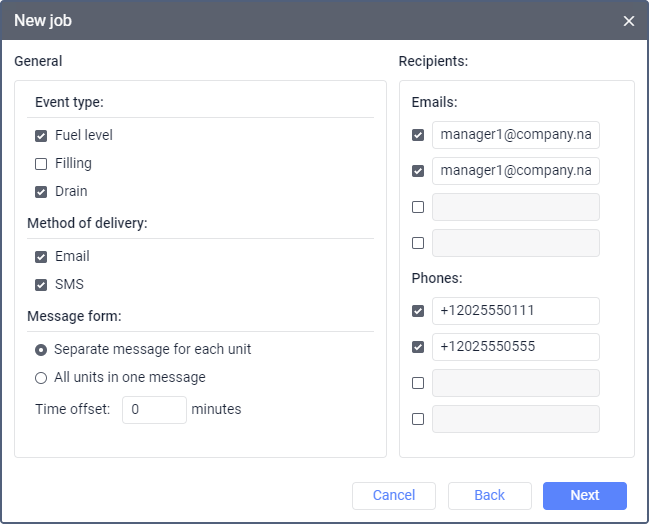Sending Fuel Information
To create the Send fuel information by email and SMS job, you should have:
- the Create, edit, delete jobs access right to the resource;
- the Use unit in jobs, notifications, routes, retranslators access right to units.
The creator of the resource in which the job is stored should also have the specified access right to units.
A job of this type allows you to receive information about fuel drains, fillings and fuel level by email or in SMS messages.

When you create the job, the following settings are available:
| Setting | Description |
|---|---|
| Event type | Select the type of events about which you want to receive information: fuel level, filling, or drain. You can select more than one. Fuel fillings and drains are detected in accordance with the settings of fuel sensors. The information about fillings and drains is sent only if they are detected. |
| Method of delivery | Select the method of receiving information: SMS and/or email. In the Recipients section on the right, specify the phone number and email address of the recipient, respectively. The phone number should be indicated in the international format. To send SMS messages, the Can send SMS option should be enabled in the user properties. To send emails, you should specify the email address from which system messages should be sent in the billing plan properties. To cancel sending information to any added phone number or address, uncheck the box to the left of it. In addition, the recipients of emails can unsubscribe from them. If the Unsubscribe feature is enabled in the properties of the account or resource where the notification is stored, an Unsubscribe link is shown at the bottom of the email. If the user unsubscribes from emails, the boxes to the left of the recipients’ email addresses are automatically unchecked in the job settings. If all the specified recipients unsubscribe, and no phone numbers are indicated in the job settings, the job is automatically disabled. |
| Message form | If several units are selected for the job, you can specify in this section whether fuel information should be sent in a separate message for each unit or in one common message. |
| Time offset | In this field, you can specify by how many minutes the interval should be extended to analyze messages for detecting fuel fillings and drains. The start time of the interval is shifted to an earlier time by the specified number of minutes (see Job execution intervals for details). This option allows taking messages from the black box into account. |
Job intervals
When the job is carried out, the interval for which fuel information is analyzed is determined as follows:
| Interval start | Interval end | |
|---|---|---|
The first job execution | The indicated activation time (minus the value from the Time offset field, if specified). | Job execution time. |
| The second and successive job executions | The time of the previous job execution (minus the value from the Time offset field, if specified). | Job execution time. |
It is not advisable to create jobs with too short intervals. If a job is carried out too frequently, for instance, every hour, then one part of a filling or drain may fall into one interval, and the other part into the next. As a result, the job may not be carried out.
Example. The job for sending information about fuel drains is carried out every hour: at 9:00, 10:00, 11:00, 12:00, etc. The minimum drain volume specified in the sensor settings is 15 litres. From 9:55 to 10:00, 10 litres of fuel was drained, and from 10:00 to 10:05 another 5 litres. The interval boundary divides the fuel drain into parts, each of which is less than 15 litres. Therefore, the job is not executed and no information is sent.
SMS format
The SMS messages that are sent when a job is executed are of the following format:
UnitName
x a/b/c
where
- UnitName — the name of the unit (it is advisable to use latin letters in unit names to fit more characters in one SMS);
- x — a sensor number;
- a — a fuel level;
- b — the volume of the filled fuel;
- c — the volume of the drained fuel.
Example. The following SMS message has been received:
Iveco_1501
1 66/-/-
2 100/-/10
It means that the unit Iveco_1501 has a fuel level of 66 litres and no fillings or drains have been detected according to the first sensor. According to the second sensor (for example, in another tank), the fuel level is 100 litres, no fillings have been carried out, but a fuel drain of 10 litres has been detected.
A dash instead of any of the values may be shown for the following reasons:
- The option for sending this value is not enabled in the Event type section of the job settings. For example, if the Fuel level option is not selected, a dash is always shown instead of the value a.
- Unable to get data (in the case of the fuel level).
- No matching events have been found (in the case of fuel fillings and drains).
Depending on the measurement system of the resource to which the job belongs, the amount of fuel can be shown in litres or gallons.